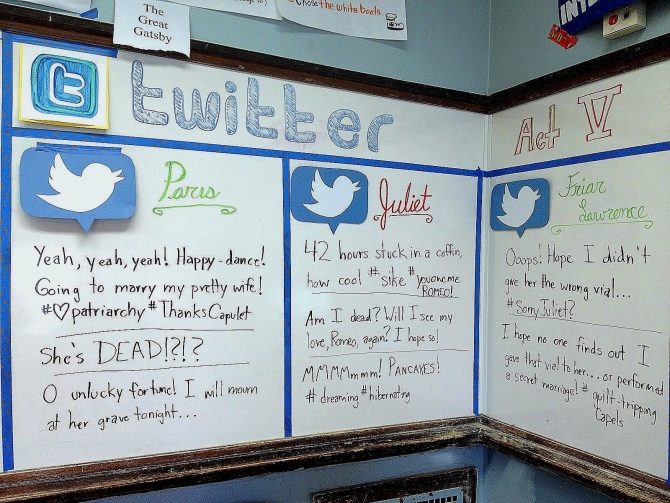
How to Use Social Media in a Low Tech Classroom
by Danielle Zipkin, English Teacher, Central Queens Academy
1. Facebook Profile Printouts
What they are: Empty graphic organizers in the format of a Facebook profile.
Linking to Common Core: Assess understanding of characterization by having students use textual evidence to complete one of these.You can also assess basic comprehension of a biographical article by attaching one of these organizers as an accompaniment.
What to do with them: Though many of my colleagues have created their own, there are many options already available online! When creating a character portfolio or scrapbook, these are a fun addition. I have also seen them posted on walls with yarn showing which characters are “friends” with one another within a given text. I have used them in non-fiction units, too, when students researched a political leader to compare and contrast with a leader in Lord of the Flies. It was much more interesting for students to compare and contrast the created profiles of Jack Merridew and Fidel Castro than to simply complete a Venn Diagram.
2. Tweet Sheets
What they are: Slips of paper with space for a username and 140 characters, meant to simulate a tweet.
Linking to Common Core: Assess understanding of summary or theme by having students use their own name as the username and “tweet” a summary or theme of what happened in the text. You can also have students use character names as usernames and post character feelings and reactions from that character’s voice to assess characterization, point of view, tone, or how elements in a story interact.
What to do with them: One of my creative colleagues, Sarah Varland, posted the tweets (pictured above) that best fulfilled the objectives on one of her whiteboards that was sectioned by character. This helped her students visualize character experiences side by side, which was extremely helpful during Romeo and Juliet. Instead of students struggling to remember major plot points from day to day, they could simply look at the “feed” on the whiteboard for a helpful and engaging reference point.
3. Instagram Tableaus
What they are: In hard copy form, this could be a sketch of a scene or a posed photograph followed by writing space with a 2,200 character limit. If you were to go paperless, you could have groups of students tableau, or pose for a still image, while one student reads the caption aloud.
Linking to Common Core: Assess understanding of summary or main idea by having students create tableaus and posts determining the major plot points in a reading. Have students use character names as usernames and thread their feelings and reactions onto other students’ posts using that character’s voice to assess characterization, tone, point of view, or how elements in a story interact. Assess theme by having students create a series of posts and comments that are all thematically connected.
What to do with them: Like the Twitter feed can be posted in the classroom, I posted my students’ Instagram tableaus on the walls of my own. From there, students can post comments on post-its, add on using the same hashtags, or like the posts. This can work when students use their own created usernames and interact with events of fiction or non-fiction, or this can work when students interact by embodying a character and using a username based on that character. In my classroom, we posted as ourselves reacting to the events and characters within A Midsummer Night’s Dream.
Though I only used examples from ELA, there are so many possibilities of modifying these activities to reach other content areas. To all of you looking to engage your learners without technology, happy modifying!
This post was originally published on TeacherPop. It has been republished here with permission from the author.
Danielle Zipkin spent two years teaching secondary English Language Arts at Schurz High School after teaching Humanities at the Boston Arts Academy. In 2014, she returned to her home state, New York, to begin her work at the Central Queens Academy middle school as a founding English teacher and Spoken Word Slam Poetry coach. She earned her Bachelors of Arts in English with minors in Secondary Education, and Theatrical Movement/Dance at Brandeis University, and most recently earned her Spoken Word Pedagogy teaching certificate through Concordia University.
Published on April 15, 2015
Read more stories about: Teacher Experience.


